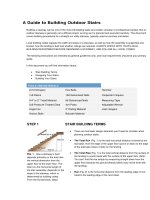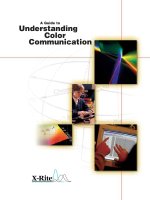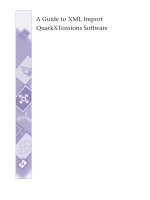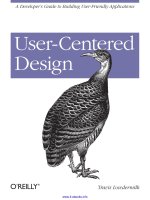Learning tensorflow a guide to building deep learning systems
Bạn đang xem bản rút gọn của tài liệu. Xem và tải ngay bản đầy đủ của tài liệu tại đây (5.96 MB, 337 trang )
LearningTensorFlow
AGuidetoBuildingDeepLearningSystems
TomHope,YehezkelS.Resheff,andItayLieder
LearningTensorFlow
byTomHope,YehezkelS.Resheff,andItayLiederCopyright©2017TomHope,ItayLieder,and
YehezkelS.Resheff.Allrightsreserved.
PrintedintheUnitedStatesofAmerica.
PublishedbyO’ReillyMedia,Inc.,1005GravensteinHighwayNorth,Sebastopol,CA95472.
O’Reillybooksmaybepurchasedforeducational,business,orsalespromotionaluse.Onlineeditionsare
alsoavailableformosttitles(Formoreinformation,contactour
corporate/institutionalsalesdepartment:800-998-9938or
Editor:NicoleTache
ProductionEditor:ShinyKalapurakkel
Copyeditor:RachelHead
Proofreader:SharonWilkey
Indexer:JudithMcConville
InteriorDesigner:DavidFutato
CoverDesigner:KarenMontgomery
Illustrator:RebeccaDemarest
August2017:FirstEdition
RevisionHistoryfortheFirstEdition
2017-08-04:FirstRelease
TheO’ReillylogoisaregisteredtrademarkofO’ReillyMedia,Inc.LearningTensorFlow,thecover
image,andrelatedtradedressaretrademarksofO’ReillyMedia,Inc.
Whilethepublisherandtheauthorshaveusedgoodfaitheffortstoensurethattheinformationand
instructionscontainedinthisworkareaccurate,thepublisherandtheauthorsdisclaimallresponsibility
forerrorsoromissions,includingwithoutlimitationresponsibilityfordamagesresultingfromtheuseof
orrelianceonthiswork.Useoftheinformationandinstructionscontainedinthisworkisatyourown
risk.Ifanycodesamplesorothertechnologythisworkcontainsordescribesissubjecttoopensource
licensesortheintellectualpropertyrightsofothers,itisyourresponsibilitytoensurethatyourusethereof
complieswithsuchlicensesand/orrights.
978-1-491-97851-1
[M]
Preface
Deeplearninghasemergedinthelastfewyearsasapremiertechnologyforbuildingintelligentsystems
thatlearnfromdata.Deepneuralnetworks,originallyroughlyinspiredbyhowthehumanbrainlearns,
aretrainedwithlargeamountsofdatatosolvecomplextaskswithunprecedentedaccuracy.Withopen
sourceframeworksmakingthistechnologywidelyavailable,itisbecomingamust-knowforanybody
involvedwithbigdataandmachinelearning.
TensorFlowiscurrentlytheleadingopensourcesoftwarefordeeplearning,usedbyarapidlygrowing
numberofpractitionersworkingoncomputervision,naturallanguageprocessing(NLP),speech
recognition,andgeneralpredictiveanalytics.
Thisbookisanend-to-endguidetoTensorFlowdesignedfordatascientists,engineers,students,and
researchers.Thebookadoptsahands-onapproachsuitableforabroadtechnicalaudience,allowing
beginnersagentlestartwhiledivingdeepintoadvancedtopicsandshowinghowtobuildproductionreadysystems.
Inthisbookyouwilllearnhowto:
1. GetupandrunningwithTensorFlow,rapidlyandpainlessly.
2. UseTensorFlowtobuildmodelsfromthegroundup.
3. TrainandunderstandpopulardeeplearningmodelsforcomputervisionandNLP.
4. Useextensiveabstractionlibrariestomakedevelopmenteasierandfaster.
5. ScaleupTensorFlowwithqueuingandmultithreading,trainingonclusters,andservingoutputin
production.
6. Andmuchmore!
ThisbookiswrittenbydatascientistswithextensiveR&Dexperienceinbothindustryandacademic
research.Theauthorstakeahands-onapproach,combiningpracticalandintuitiveexamples,illustrations,
andinsightssuitableforpractitionersseekingtobuildproduction-readysystems,aswellasreaders
lookingtolearntounderstandandbuildflexibleandpowerfulmodels.
Prerequisites
ThisbookassumessomebasicPythonprogrammingknow-how,includingbasicfamiliaritywiththe
scientificlibraryNumPy.
Machinelearningconceptsaretoucheduponandintuitivelyexplainedthroughoutthebook.Forreaders
whowanttogainadeeperunderstanding,areasonablelevelofknowledgeinmachinelearning,linear
algebra,calculus,probability,andstatisticsisrecommended.
ConventionsUsedinThisBook
Thefollowingtypographicalconventionsareusedinthisbook:
Italic
Indicatesnewterms,URLs,emailaddresses,filenames,andfileextensions.
Constantwidth
Usedforprogramlistings,aswellaswithinparagraphstorefertoprogramelementssuchas
variableorfunctionnames,databases,datatypes,environmentvariables,statements,andkeywords.
Constantwidthbold
Showscommandsorothertextthatshouldbetypedliterallybytheuser.
Constantwidthitalic
Showstextthatshouldbereplacedwithuser-suppliedvaluesorbyvaluesdeterminedbycontext.
UsingCodeExamples
Supplementalmaterial(codeexamples,exercises,etc.)isavailablefordownloadat
/>Thisbookisheretohelpyougetyourjobdone.Ingeneral,ifexamplecodeisofferedwiththisbook,you
mayuseitinyourprogramsanddocumentation.Youdonotneedtocontactusforpermissionunless
you’rereproducingasignificantportionofthecode.Forexample,writingaprogramthatusesseveral
chunksofcodefromthisbookdoesnotrequirepermission.SellingordistributingaCD-ROMof
examplesfromO’Reillybooksdoesrequirepermission.Answeringaquestionbycitingthisbookand
quotingexamplecodedoesnotrequirepermission.Incorporatingasignificantamountofexamplecode
fromthisbookintoyourproduct’sdocumentationdoesrequirepermission.
Weappreciate,butdonotrequire,attribution.Anattributionusuallyincludesthetitle,author,publisher,
andISBN.Forexample:“LearningTensorFlowbyTomHope,YehezkelS.Resheff,andItayLieder
(O’Reilly).Copyright2017TomHope,ItayLieder,andYehezkelS.Resheff,978-1-491-97851-1.”
Ifyoufeelyouruseofcodeexamplesfallsoutsidefairuseorthepermissiongivenabove,feelfreeto
contactusat
O’ReillySafari
NOTE
Safari(formerlySafariBooksOnline)isamembership-basedtrainingandreferenceplatformfor
enterprise,government,educators,andindividuals.
Membershaveaccesstothousandsofbooks,trainingvideos,LearningPaths,interactivetutorials,and
curatedplaylistsfromover250publishers,includingO’ReillyMedia,HarvardBusinessReview,
PrenticeHallProfessional,Addison-WesleyProfessional,MicrosoftPress,Sams,Que,PeachpitPress,
Adobe,FocalPress,CiscoPress,JohnWiley&Sons,Syngress,MorganKaufmann,IBMRedbooks,
Packt,AdobePress,FTPress,Apress,Manning,NewRiders,McGraw-Hill,Jones&Bartlett,and
CourseTechnology,amongothers.
Formoreinformation,pleasevisit />
HowtoContactUs
Pleaseaddresscommentsandquestionsconcerningthisbooktothepublisher:
O’ReillyMedia,Inc.
1005GravensteinHighwayNorth
Sebastopol,CA95472
800-998-9938(intheUnitedStatesorCanada)
707-829-0515(internationalorlocal)
707-829-0104(fax)
Wehaveawebpageforthisbook,wherewelisterrata,examples,andanyadditionalinformation.You
canaccessthispageat />Tocommentorasktechnicalquestionsaboutthisbook,sendemailto
Formoreinformationaboutourbooks,courses,conferences,andnews,seeourwebsiteat
.
FindusonFacebook: />FollowusonTwitter: />WatchusonYouTube: />
Acknowledgments
Theauthorswouldliketothankthereviewerswhoofferedfeedbackonthisbook:ChrisFregly,Marvin
Bertin,OrenSarShalom,andYoniLavi.WewouldalsoliketothankNicoleTacheandtheO’Reillyteam
formakingitapleasuretowritethebook.
Ofcourse,thankstoallthepeopleatGooglewithoutwhomTensorFlowwouldnotexist.
Chapter1.Introduction
Thischapterprovidesahigh-leveloverviewofTensorFlowanditsprimaryuse:implementingand
deployingdeeplearningsystems.Webeginwithaverybriefintroductorylookatdeeplearning.Wethen
presentTensorFlow,showcasingsomeofitsexcitingusesforbuildingmachineintelligence,andthenlay
outitskeyfeaturesandproperties.
GoingDeep
Fromlargecorporationstobuddingstartups,engineersanddatascientistsarecollectinghugeamountsof
dataandusingmachinelearningalgorithmstoanswercomplexquestionsandbuildintelligentsystems.
Whereveronelooksinthislandscape,theclassofalgorithmsassociatedwithdeeplearninghaverecently
seengreatsuccess,oftenleavingtraditionalmethodsinthedust.Deeplearningisusedtodayto
understandthecontentofimages,naturallanguage,andspeech,insystemsrangingfrommobileappsto
autonomousvehicles.Developmentsinthisfieldaretakingplaceatbreakneckspeed,withdeeplearning
beingextendedtootherdomainsandtypesofdata,likecomplexchemicalandgeneticstructuresfordrug
discoveryandhigh-dimensionalmedicalrecordsinpublichealthcare.
Deeplearningmethods—whichalsogobythenameofdeepneuralnetworks—wereoriginallyroughly
inspiredbythehumanbrain’svastnetworkofinterconnectedneurons.Indeeplearning,wefeedmillions
ofdatainstancesintoanetworkofneurons,teachingthemtorecognizepatternsfromrawinputs.Thedeep
neuralnetworkstakerawinputs(suchaspixelvaluesinanimage)andtransformthemintouseful
representations,extractinghigher-levelfeatures(suchasshapesandedgesinimages)thatcapture
complexconceptsbycombiningsmallerandsmallerpiecesofinformationtosolvechallengingtaskssuch
asimageclassification(Figure1-1).Thenetworksautomaticallylearntobuildabstractrepresentations
byadaptingandcorrectingthemselves,fittingpatternsobservedinthedata.Theabilitytoautomatically
constructdatarepresentationsisakeyadvantageofdeepneuralnetsoverconventionalmachinelearning,
whichtypicallyrequiresdomainexpertiseandmanualfeatureengineeringbeforeany“learning”can
occur.
Figure1-1.Anillustrationofimageclassificationwithdeepneuralnetworks.Thenetworktakesrawinputs(pixelvaluesinanimage)
andlearnstotransformthemintousefulrepresentations,inordertoobtainanaccurateimageclassification.
ThisbookisaboutGoogle’sframeworkfordeeplearning,TensorFlow.Deeplearningalgorithmshave
beenusedforseveralyearsacrossmanyproductsandareasatGoogle,suchassearch,translation,
advertising,computervision,andspeechrecognition.TensorFlowis,infact,asecond-generationsystem
forimplementinganddeployingdeepneuralnetworksatGoogle,succeedingtheDistBeliefprojectthat
startedin2011.
TensorFlowwasreleasedtothepublicasanopensourceframeworkwithanApache2.0licensein
November2015andhasalreadytakentheindustrybystorm,withadoptiongoingfarbeyondinternal
Googleprojects.Itsscalabilityandflexibility,combinedwiththeformidableforceofGoogleengineers
whocontinuetomaintainanddevelopit,havemadeTensorFlowtheleadingsystemfordoingdeep
learning.
UsingTensorFlowforAISystems
BeforegoingintomoredepthaboutwhatTensorFlowisanditskeyfeatures,wewillbrieflygivesome
excitingexamplesofhowTensorFlowisusedinsomecutting-edgereal-worldapplications,atGoogle
andbeyond.
Pre-trainedmodels:state-of-the-artcomputervisionforall
Oneprimaryareawheredeeplearningistrulyshiningiscomputervision.Afundamentaltaskincomputer
visionisimageclassification—buildingalgorithmsandsystemsthatreceiveimagesasinput,andreturn
asetofcategoriesthatbestdescribethem.Researchers,datascientists,andengineershavedesigned
advanceddeepneuralnetworksthatobtainhighlyaccurateresultsinunderstandingvisualcontent.These
deepnetworksaretypicallytrainedonlargeamountsofimagedata,takingmuchtime,resources,and
effort.However,inagrowingtrend,researchersarepubliclyreleasingpre-trainedmodels—deepneural
netsthatarealreadytrainedandthatuserscandownloadandapplytotheirdata(Figure1-2).
Figure1-2.Advancedcomputervisionwithpre-trainedTensorFlowmodels.
TensorFlowcomeswithusefulutilitiesallowinguserstoobtainandapplycutting-edgepretrained
models.Wewillseeseveralpracticalexamplesanddiveintothedetailsthroughoutthisbook.
Generatingrichnaturallanguagedescriptionsforimages
Oneexcitingareaofdeeplearningresearchforbuildingmachineintelligencesystemsisfocusedon
generatingnaturallanguagedescriptionsforvisualcontent(Figure1-3).Akeytaskinthisareaisimage
captioning—teachingthemodeltooutputsuccinctandaccuratecaptionsforimages.Heretoo,advanced
pre-trainedTensorFlowmodelsthatcombinenaturallanguageunderstandingwithcomputervisionare
available.
Figure1-3.Goingfromimagestotextwithimagecaptioning(illustrativeexample).
Textsummarization
Naturallanguageunderstanding(NLU)isakeycapabilityforbuildingAIsystems.Tremendousamounts
oftextaregeneratedeveryday:webcontent,socialmedia,news,emails,internalcorporate
correspondences,andmanymore.Oneofthemostsought-afterabilitiesistosummarizetext,takinglong
documentsandgeneratingsuccinctandcoherentsentencesthatextractthekeyinformationfromthe
originaltexts(Figure1-4).Aswewillseelaterinthisbook,TensorFlowcomeswithpowerfulfeatures
fortrainingdeepNLUnetworks,whichcanalsobeusedforautomatictextsummarization.
Figure1-4.Anillustrationofsmarttextsummarization.
TensorFlow:What’sinaName?
Deepneuralnetworks,asthetermandtheillustrationswe’veshownimply,areallaboutnetworksof
neurons,witheachneuronlearningtodoitsownoperationaspartofalargerpicture.Datasuchasimages
entersthisnetworkasinput,andflowsthroughthenetworkasitadaptsitselfattrainingtimeorpredicts
outputsinadeployedsystem.
Tensorsarethestandardwayofrepresentingdataindeeplearning.Simplyput,tensorsarejust
multidimensionalarrays,anextensionoftwo-dimensionaltables(matrices)todatawithhigher
dimensionality.Justasablack-and-white(grayscale)imagesarerepresentedas“tables”ofpixelvalues,
RGBimagesarerepresentedastensors(three-dimensionalarrays),witheachpixelhavingthreevalues
correspondingtored,green,andbluecomponents.
InTensorFlow,computationisapproachedasadataflowgraph(Figure1-5).Broadlyspeaking,inthis
graph,nodesrepresentoperations(suchasadditionormultiplication),andedgesrepresentdata(tensors)
flowingaroundthesystem.Inthenextchapters,wewilldivedeeperintotheseconceptsandlearnto
understandthemwithmanyexamples.
Figure1-5.Adataflowcomputationgraph.Dataintheformoftensorsflowsthroughagraphofcomputationaloperationsthatmake
upourdeepneuralnetworks.
AHigh-LevelOverview
TensorFlow,inthemostgeneralterms,isasoftwareframeworkfornumericalcomputationsbasedon
dataflowgraphs.Itisdesignedprimarily,however,asaninterfaceforexpressingandimplementing
machinelearningalgorithms,chiefamongthemdeepneuralnetworks.
TensorFlowwasdesignedwithportabilityinmind,enablingthesecomputationgraphstobeexecuted
acrossawidevarietyofenvironmentsandhardwareplatforms.Withessentiallyidenticalcode,thesame
TensorFlowneuralnetcould,forinstance,betrainedinthecloud,distributedoveraclusterofmany
machinesoronasinglelaptop.Itcanbedeployedforservingpredictionsonadedicatedserveroron
mobiledeviceplatformssuchasAndroidoriOS,orRaspberryPisingle-boardcomputers.TensorFlowis
alsocompatible,ofcourse,withLinux,macOS,andWindowsoperatingsystems.
ThecoreofTensorFlowisinC++,andithastwoprimaryhigh-levelfrontendlanguagesandinterfaces
forexpressingandexecutingthecomputationgraphs.ThemostdevelopedfrontendisinPython,usedby
mostresearchersanddatascientists.TheC++frontendprovidesquitealow-levelAPI,usefulfor
efficientexecutioninembeddedsystemsandotherscenarios.
Asidefromitsportability,anotherkeyaspectofTensorFlowisitsflexibility,allowingresearchersand
datascientiststoexpressmodelswithrelativeease.Itissometimesrevealingtothinkofmoderndeep
learningresearchandpracticeasplayingwith“LEGO-like”bricks,replacingblocksofthenetworkwith
othersandseeingwhathappens,andattimesdesigningnewblocks.Asweshallseethroughoutthisbook,
TensorFlowprovideshelpfultoolstousethesemodularblocks,combinedwithaflexibleAPIthat
enablesthewritingofnewones.Indeeplearning,networksaretrainedwithafeedbackprocesscalled
backpropagationbasedongradientdescentoptimization.TensorFlowflexiblysupportsmanyoptimization
algorithms,allwithautomaticdifferentiation—theuserdoesnotneedtospecifyanygradientsin
advance,sinceTensorFlowderivesthemautomaticallybasedonthecomputationgraphandlossfunction
providedbytheuser.Tomonitor,debug,andvisualizethetrainingprocess,andtostreamline
experiments,TensorFlowcomeswithTensorBoard(Figure1-6),asimplevisualizationtoolthatrunsin
thebrowser,whichwewillusethroughoutthisbook.
Figure1-6.TensorFlow’svisualizationtool,TensorBoard,formonitoring,debugging,andanalyzingthetrainingprocessand
experiments.
KeyenablersofTensorFlow’sflexibilityfordatascientistsandresearchersarehigh-levelabstraction
libraries.Instate-of-the-artdeepneuralnetsforcomputervisionorNLU,writingTensorFlowcodecan
takeatoll—itcanbecomeacomplex,lengthy,andcumbersomeendeavor.Abstractionlibrariessuchas
KerasandTF-Slimoffersimplifiedhigh-levelaccesstothe“LEGObricks”inthelower-levellibrary,
helpingtostreamlinetheconstructionofthedataflowgraphs,trainingthem,andrunninginference.
AnotherkeyenablerfordatascientistsandengineersisthepretrainedmodelsthatcomewithTF-Slimand
TensorFlow.Thesemodelsweretrainedonmassiveamountsofdatawithgreatcomputationalresources,
whichareoftenhardtocomebyandinanycaserequiremuchefforttoacquireandsetup.UsingKerasor
TF-Slim,forexample,withjustafewlinesofcodeitispossibletousetheseadvancedmodelsfor
inferenceonincomingdata,andalsotofine-tunethemodelstoadapttonewdata.
TheflexibilityandportabilityofTensorFlowhelpmaketheflowfromresearchtoproductionsmooth,
cuttingthetimeandeffortittakesfordatascientiststopushtheirmodelstodeploymentinproductsand
forengineerstotranslatealgorithmicideasintorobustcode.
TENSORFLOWABSTRACTIONS
TensorFlowcomeswithabstractionlibrariessuchasKerasandTF-Slim,offeringsimplifiedhigh-levelaccesstoTensorFlow.
Theseabstractions,whichwewillseelaterinthisbook,helpstreamlinetheconstructionofthedataflowgraphsandenableusto
trainthemandruninferencewithmanyfewerlinesofcode.
Butbeyondflexibilityandportability,TensorFlowhasasuiteofpropertiesandtoolsthatmakeit
attractiveforengineerswhobuildreal-worldAIsystems.Ithasnaturalsupportfordistributedtraining—
indeed,itisusedatGoogleandotherlargeindustryplayerstotrainmassivenetworksonhugeamountsof
data,overclustersofmanymachines.Inlocalimplementations,trainingonmultiplehardwaredevices
requiresfewchangestocodeusedforsingledevices.Codealsoremainsrelativelyunchangedwhen
goingfromlocaltodistributed,whichmakesusingTensorFlowinthecloud,onAmazonWebServices
(AWS)orGoogleCloud,particularlyattractive.Additionally,aswewillseefurtheralonginthisbook,
TensorFlowcomeswithmanymorefeaturesaimedatboostingscalability.Theseincludesupportfor
asynchronouscomputationwiththreadingandqueues,efficientI/Oanddataformats,andmuchmore.
Deeplearningcontinuestorapidlyevolve,andsodoesTensorFlow,withfrequentnewandexciting
additions,bringingbetterusability,performance,andvalue.
Summary
Withthesetoftoolsandfeaturesdescribedinthischapter,itbecomesclearwhyTensorFlowhas
attractedsomuchattentioninlittlemorethanayear.Thisbookaimsatfirstrapidlygettingyouacquainted
withthebasicsandreadytowork,andthenwewilldivedeeperintotheworldofTensorFlowwith
excitingandpracticalexamples.
Chapter2.GowiththeFlow:UpandRunning
withTensorFlow
InthischapterwestartourjourneywithtwoworkingTensorFlowexamples.Thefirst(thetraditional
“helloworld”program),whileshortandsimple,includesmanyoftheimportantelementswediscussin
depthinlaterchapters.Withthesecond,afirstend-to-endmachinelearningmodel,youwillembarkon
yourjourneytowardstate-of-the-artmachinelearningwithTensorFlow.
Beforegettingstarted,webrieflywalkthroughtheinstallationofTensorFlow.Inordertofacilitatea
quickandpainlessstart,weinstalltheCPUversiononly,anddefertheGPUinstallationtolater.1(Ifyou
don’tknowwhatthismeans,that’sOKforthetimebeing!)IfyoualreadyhaveTensorFlowinstalled,skip
tothesecondsection.









